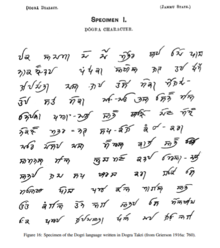lingvo.wikisort.org - Alphabet
Dogri (Name Dogra Akkhar: 𑠖𑠵𑠌𑠤𑠮; Devanagari: डोगरी; Nastaliq: ڈوگری; IPA: [ɖoːɡɾiː]) is a Northern Indo-Aryan language spoken by about five million people[3] in India, chiefly in the Jammu region of Jammu and Kashmir. It is also spoken in the adjoining regions of western Himachal Pradesh and northern Punjab.[4] It is also spoken in north-eastern parts of Punjab, Pakistan.[5][6] It is the ethnic language of the Dogras, and is spoken in the historical region of Duggar. Dogri is a member of the Western Pahari group of languages.[7] Unusually for an Indo-European language, Dogri is tonal,[8] a trait it shares with other Western Pahari languages and Punjabi. It has several varieties, all with greater than 80% lexical similarity (within Jammu and Kashmir).[9]
| Dogri | |
|---|---|
| 𑠖𑠵𑠌𑠤𑠮, डोगरी, ڈوگری | |
   | |
| Native to | India, Pakistan |
| Region | Jammu region, Western Himachal Pradesh, Punjab |
| Ethnicity | Dogras |
Native speakers | 2.6 million (2011 census)[1] |
Language family | |
Writing system | Name Dogra Akkhar version of Takri script Devanagari Perso-Arabic (Nastaʼlīq) Mahajani (historically) |
| Official status | |
Official language in | |
| Language codes | |
| ISO 639-2 | doi |
| ISO 639-3 | doi – inclusive codeIndividual codes: dgo – Dogri properxnr – Kangri |
| Glottolog | indo1311 |
| Part of a series on | |
|---|---|
| |
| Constitutionally recognised languages of India | |
| Category | |
| 22 Official Languages of the Indian Republic | |
|
Assamese
·
Bengali
·
Bodo
·
Dogri
·
Gujarati
| |
| Related | |
|
Eighth Schedule to the Constitution of India
| |
|
Dogri is one of the 22 official languages of India. It was added in the 8th schedule of the constitution in 2003. It is also one of the 5 official languages of the union territory of Jammu and Kashmir.
Script
Dogri was originally written in the old Dogra Akkhar script – a modified version of Takri.[10] A modified version of this script was created by the order of Maharaja Ranbir Singh of Jammu and Kashmir, which was then called Name Dogra Akkhar.[11] Official documents were written in this new script; however it never caught on among the general Dogri-speaking populace. Currently, Devanagari is the officially recognised script for Dogri in India and virtually all Dogri literature is published in it.


Phonology
Consonants
| Labial | Dental/ Alveolar |
Retroflex | Post-alv./ Palatal |
Velar | Glottal | ||
|---|---|---|---|---|---|---|---|
| Nasal | m | n | ɳ | ɲ | ŋ | ||
| Plosive/ Affricate |
voiceless | p | t̪ | ʈ | tʃ | k | |
| aspirated | pʰ | t̪ʰ | ʈʰ | tʃʰ | kʰ | ||
| voiced | b | d̪ | ɖ | dʒ | ɡ | ||
| Fricative | voiceless | (f) | s | ʃ | (x) | ||
| voiced | (z) | (ɣ) | ɦ | ||||
| Tap | ɾ | ɽ | |||||
| Approximant | ʋ | l | j | ||||
- Gemination occurs in all consonants except the consonants /ɾ ɳ ɽ ʃ/.
- Retroflex consonants /ɽ ɳ/ rarely occur in word initial position.
- /f z x ɣ/ only occur from Perso-Arabic loan words. /f/ is also heard as an allophone of /pʰ/.
- /ɾ/ can also marginally be heard as trilled [r] in some speech.
- In some words, /s/ can become more weakly pronounced, or even eliminated and replaced by a glottal fricative sound [h].
- A palatal nasal sound [ɲ] typically occurs when a dental nasal precedes a post-alveolar affricate consonant, rarely occurring in words word-initially or medially.
- A velar nasal sound [ŋ] typically occurs when a dental nasal precedes a velar plosive consonant, and rarely occurs word-initially or medially.[12]
Vowels
| Front | Central | Back | |
|---|---|---|---|
| Close | iː | uː | |
| Near-close | ɪ | ʊ | |
| Close-mid | eː | ə | oː |
| Open-mid | ɛː | ɔː | |
| Open | aː | ||
- There are nasalized variations of the following vowels /ĩ ũ ẽ õ ɛ̃ ɔ̃ ã/.[13]
- Vowel sounds are often nasalized when occurring before a word-medial or word-final /n/, except when /n/ occurs before a word-final vowel.
- /ʊ/ can have a marginal upgliding allophone [ʊᵛ] when occurring before a /a/ vowel sound.
- A word-final /aː/ is realized as a back sound [ɑː] and may also drift toward a centralized [äː] sound.[12]
Some common words
| Name Dogra Akkhar | Devanagari | Perso-Arabic | IPA | English translation |
|---|---|---|---|---|
| 𑠪𑠬𑠷 | हां | ہاں | [ã̀ː] | Yes |
| 𑠝𑠳𑠃𑠷 | नेईं | نےئیں | [neːĩː] | No |
| 𑠪𑠭𑠤𑠋 | हिरख | ہرکھ | [ɪ̀ɾkʰ] | Love |
| 𑠊𑠝𑠹𑠝𑠴 | कन्नै | کنّے | [kənːɛː] | With |
| 𑠊𑠳𑠪𑠹 | केह् | کیہ | [kéː] | What |
| 𑠊𑠮 | की | کی | [kiː] | Why |
| 𑠌𑠬𑠩 | गास | گاس | [gaːs] | Sky |
| 𑠠'𑠤𑠬 | ब'रा | ب'را | [bə́ɾaː] | Year |
Tone rules
These are rules of writing tones in Dogri using Devanagari Script. They are as follows:-
- Just like Punjabi, Dogri also uses the letters घ (gʱə), झ (d͡ʒʱə), ढ (ɖʱə), ध (d̪ʱə), भ (bʱə) and ढ़ (ɽʱə) for tonal uses. When at the beginning of the word, it has a high-falling tone; i.e.:- घ (kə̀), झ (t͡ʃə̀), ढ (ʈə̀), ध (t̪ə̀), भ (pə̀) and ढ़ (ɽə̀). When in the middle and final position of the word, the preceding vowel has a low-rising tone; i.e.:- अघ (ə́ɡ), अझ (ə́d͡ʒ), अढ (ə́ɖ), अध (ə́d̪), अभ (ə́b) and अढ़ (ə́ɽ). Examples:- घड़ी (kə̀ɽiː)- clock, and बध (bə́d̪).
- Unlike Punjabi, there is no ह (ɦə) sound and it has a high-falling tone in all positions; i.e.:- हत्थ (ə̀t̪ːʰə)- hand.
- To indicate a low-rising tone in the middle of words, Dogri uses ह् (ह with a halant) to indicate it when the preceding vowel is long; i.e.:- आ (aː), ई (iː), ऊ (uː), ए (eː), ऐ (ɛː), ओ (oː) and औ (ɔː). Example:- साह्ब (sáːb)- sahab. When the preceding vowel is short, i.e., - अ (ə), इ (ɪ) and उ (ʊ); an apostrophe mark (') is used. Example:- ल'त्त (lə́tː)- leg.
- The characters mentioned in the first point can also be used to indicate high-falling tone in the middle of the words when between a short vowel and a long vowel.
Some examples are shown below.
| Name Dogra Akkhar | Devanagari | Perso-Arabic | IPA | Tone | English translation |
|---|---|---|---|---|---|
| 𑠌𑠥𑠹𑠥 | गल्ल | گلّ | [gəlːə] | Equal | Thing |
| 𑠌'𑠥𑠹𑠥 | ग'ल्ल | گ'لّ | [gə́lːə] | Rising | Cheek |
| 𑠊𑠤 | कर | کر | [kəɾ] | Equal | Do |
| 𑠍𑠤 | घर | گھر | [kə̀ɾ] | Falling | Home |
Historical references
In the year 1317, Amir Khusro, the famous Urdu and Persian poet, referred to Duger (Dogri) while describing the languages and dialects of India as follows: "Sindhi-o-Lahori-o-Kashmiri-o-Duger."[14][15]
Theories on name origin
Intellectuals in the court of Maharaja Ranbir Singh of Jammu and Kashmir described Duggar as a distorted form of the word Dwigarta, which means 'two troughs', a possible reference to the Mansar and Surinsar lakes.[16]
The linguist George Grierson connected the term Duggar with the Rajasthani word Doonger which means 'hill', and Dogra with Donger.[16] This opinion has lacked support because of the inconsistency of the ostensible changes from Rajasthani to Dogri (essentially the question of how Doonger became Duggar while Donger became Dogra), and has been contradicted by some scholars.[17]
Yet another proposal stems from the word Durgara, the name of a kingdom mentioned in an eleventh century copper-plate inscription in the Bhuri Singh Museum in Chamba, Himachal Pradesh.[citation needed] The word Durgara means 'invincible' in several Northern Indo-Aryan languages, and could be an allusion to the ruggedness of the terrain of Duggar and the historically militarised and autonomous Dogra societies.[citation needed]
In 1976, the experts attending the Language Session of the All India Oriental Conference held in Dharwad, Karnataka, could not reach consensus on the Dwigarta and Durgara hypotheses, but did manage agreement on a Doonger-Duggar connection. In a subsequent All India Oriental Conference held at Jaipur in 1982, the linguists agreed that the culture, language and history of Rajasthan and Duggar share some similarities. It was also suggested that the words Duggar and Dogra are common in some parts of Rajasthan. Specifically, it was asserted that areas with many forts are called Duggar, and their inhabitants are accordingly known as Dogras. The land of Duggar also has many forts, which may support the above opinion.
An article by Dharam Chand Prashant in the literary magazine Shiraza Dogri suggested that "the opinion that the word Duggar is a form of the word Duggarh sounds appropriate."[18]
Recent history
In modern times, a notable Dogri translation (in the New Dogra script) of the Sanskrit classic mathematical opus Lilavati, by the noted mathematician Bhaskaracharya (b. 1114 AD), was published by the Vidya Vilas Press, Jammu in 1873.[19] As Sanskrit literacy remained confined to a few, the late Maharaja Ranbir Singh had the Lilavati translated into Dogri by Jyotshi Bisheshwar, then principal of Jammu Pathshala.[20]
Dogri has an established tradition of poetry, fiction and dramatic works. Recent poets range from the 18th-century Dogri poet Kavi Dattu (1725–1780) in Raja Ranjit Dev's court to Professor Ram Nath Shastri and Mrs. Padma Sachdev. Kavi Dattu is highly regarded for his Barah Massa (Twelve Months), Kamal Netra (Lotus Eyes), Bhup Bijog and Bir Bilas.[21] Shiraza Dogri is a Dogri literary periodical issued by the Jammu and Kashmir Academy of Art, Culture and Languages, which is a notable publisher of modern Dogri literary work, another being the Dogri Sanstha. Popular recent songs include Pala Shapaiya Dogariya, Manne di Mauj and Shhori Deya. The noted Pakistani singer Malika Pukhraj had roots in Duggar,[22] and her renditions of several Dogri songs continue to be popular in the region. Some devotional songs (bhajans) composed by Karan Singh have gained increasing popularity over time, including Kaun Kareyaan Teri Aarti.
Dogri programming features regularly on Radio Kashmir (a division of All India Radio), and Doordarshan (Indian state television) broadcasts in Jammu and Kashmir. However, Dogri does not have a dedicated state television channel yet, unlike Kashmiri (which has the Doordarshan Koshur channel, available on cable and satellite television throughout India).[citation needed]
Official recognition of the language has been gradual, but progressive. On 2 August 1969, the General Council of the Sahitya Academy, Delhi recognized Dogri as an "independent modern literary language" of India, based on the unanimous recommendation of a panel of linguists.[23] Dogri is one of the official languages of the Indian union territory of Jammu and Kashmir. On 22 December 2003, in a major milestone for the official status of the language, Dogri was recognized as a national language of India in the Indian constitution.[24][25]
In 2005, a collection of over 100 works of prose and poetry in Dogri published over the last 50 years was made accessible online at the Central Institute of Indian Languages (CIIL), Mysore. This included works of eminent writer Dhinu Bhai Panth, Professor Madan Mohan Sharma, B.P. Sathai and Ram Nath Shastri.[26]
Sample text
The following text is from Article 1 of the Universal Declaration of Human Rights.
| Dogri (Name Dogra Akkhar script) | 𑠩𑠬𑠤𑠳 𑠢𑠝𑠯𑠊𑠹𑠋 𑠢𑠴𑠪𑠹𑠢𑠬 𑠙𑠳 𑠀𑠜𑠭𑠊𑠬𑠤𑠳𑠷 𑠛𑠳 𑠠𑠭𑠧𑠳 𑠏 𑠑𑠝𑠢𑠴 𑠚𑠢𑠬𑠷 𑠩𑠯𑠙𑠴𑠷𑠙𑠤 𑠙𑠳 𑠠𑠤𑠵𑠠𑠤 𑠝। 𑠄'𑠝𑠳𑠷𑠌𑠮 𑠠𑠯𑠛𑠹𑠜𑠭 𑠙𑠳 𑠑𑠢𑠮𑠤𑠴 𑠛𑠮 𑠛𑠳𑠝 𑠚𑠹𑠪𑠵𑠃 𑠇 𑠙𑠳 𑠄'𑠝𑠳𑠷𑠌𑠮 𑠁𑠞𑠰𑠷-𑠠𑠭𑠏𑠹𑠏𑠳𑠷 𑠡𑠬𑠃𑠏𑠬𑠤𑠳 𑠛𑠳 𑠡𑠬𑠦𑠴 𑠊𑠝𑠹𑠝𑠴 𑠠𑠹𑠣𑠪𑠬𑠤 𑠊𑠤𑠝𑠬 𑠥𑠵𑠫𑠛𑠬 𑠇। |
|---|---|
| Dogri (Devanagari script) | सारे मनुक्ख मैह्मा ते अधिकारें दे बिशे च जनमै थमां सुतैंतर ते बरोबर न। उ'नेंगी बुद्धि ते जमीरै दी देन थ्होई ऐ ते उ'नेंगी आपूं-बिच्चें भाईचारे दे भावै कन्नै ब्यहार करना लोड़दा ऐ। |
| Dogri (Perso-Arabic script) | سارے منکّھ میہما تے ادھکاریں دے بشے چ جنمے تھماں ستیںتر تے بروبر ن۔ ا'نیںگی بدّھ تے جمیرے دی دین تھہوئی اے تے ا'نیںگی آپوں-بچّیں بھائیچارے دے بھاوے کنّے بیہار کرنا لوڑدا اے۔ |
| Dogri transliteration (ISO 15919) | Sārē manukkha maihmā tē adhikārēṁ dē biśē ca janamai thamāṁ sutaintar tē barōbar na. U'nēṁgī buddhi tē jamīrai dī dēn thhōī ai tē u'nēṁgī āpūṁ-biccēṁ bhāīcārē dē bhāvai kannai byahār karanā lōṛadā ai. |
| Dogri IPA | [saːɾeː mənʊkːʰə mɛ́ːmaː t̪eː əd̪ɪ̀kaːɾẽː d̪eː bɪʃeː ʧə ʤənəmɛː t̪ʰəmãː sut̪ɛːnt̪əɾ t̪eː bəɾoːbəɾ nə ‖ ʊ́nẽːgiː bʊ́d̪ːɪ t̪eː dʒəmiːɾɛː d̪iː d̪eːn t̪ʰòːiː ɛː t̪eː ʊ́nẽːgiː aːpũːbɪʧːẽː pàːiːʧaːɾeː d̪eː pàːvɛː kənːɛː bjəàːɾ kəɾənaː loːɽəd̪aː ɛː ‖] |
| English translation | All human beings are born free and equal in dignity and rights. They are endowed with reason and conscience and should act towards one another in a spirit of brotherhood. |
See also
- Name Dogra Akkhar
- Western Pahari languages
- Dogras
- Duggar
- List of Sahitya Akademi Award winners for Dogri
- Dogri cinema
- Languages of India
References
- Census India, Statement 1: Abstract of Speakers' Strength of Languages and Mother Tongues 2011
- "The Jammu and Kashmir Official Languages Bill, 2020". prsindia. 23 September 2020. Retrieved 23 September 2020.
- Sharma, Sita Ram (1992). Encyclopaedia of Teaching Languages in India, v. 20. Anmol Publications. p. 6. ISBN 9788170415459.
- "Dogri". Ethnologue. Retrieved 15 July 2022.
- Billawaria, Anita K. (1978). History and Culture of Himalayan States, v.4. Light & Life Publishers.
- Cultural Forum. India (Republic) Ministry of Scientific Research and Cultural Affairs. 1970.
- Masica, Colin P. (1993). The Indo-Aryan Languages. Cambridge University Press. p. 427. ISBN 978-0-521-29944-2.
-
Ghai, Ved Kumari (1991). Studies in Phonetics and Phonology: With Special Reference to Dogri. Ariana Publishing House. ISBN 978-81-85347-20-2.
non-Dogri speakers, also trained phoneticians, tend to hear the difference as one of length only, perceiving the second syllable as stressed
- Brightbill, Jeremy D.; Turner, Scott B. (2007). "A Sociolinguistic Survey of the Dogri Language, Jammu and Kashmir" (PDF). SIL International. Retrieved 11 March 2016.
- Pandey, Anshuman (4 November 2015). "L2/15-234R: Proposal to encode the Dogra script in Unicode" (PDF).
- "NammeDograAkkhar" (PDF).
- Bahri, Ujjal Singh (2001). Dogri: Phonology and Grammatical Sketch. Series in Indian Languages and Linguistics, 24: New Delhi: Bahri Publications.
{{cite book}}: CS1 maint: location (link) - "Dogri". lisindia.ciil.org. Retrieved 9 December 2021.
- Shastri, Ram Nath (1981). Dogri Prose Writing before Independence (Translated). Dogri Research Centre, Jammu University.
- Datta, Amaresh (1987). Encyclopaedia of Indian Literature. Sahitya Akademi. ISBN 9780836422832.
- Pathik, Jyoteeshwar (1980). Cultural Heritage of the Dogras. Light & Life Publishers.
- Bahri, Ujjal Singh (2001). Dogri: Phonology and Grammatical Sketch. Bahri Publications.
- Prashant, Dharam Chand (April–May 1991). "Duggar Shabad di Vayakha". Shiraza Dogri.
- Bhāskarācārya (1873). Līlāvatī (Dogri translation). Jammu: Vidya Vilas.
- Sharma, B. P. Century-Old Printed Dogri Literature. Jammu & Kashmir State Research Biannual.
- Jerath, Ashok (1988). Dogra Legends of Art & Culture. Indus Publishing. p. 236. ISBN 978-81-7387-082-8.
- Joseph, Suad; Najmabadi, Afsaneh (2003). Encyclopedia of Women & Islamic Cultures. Leiden: Brill. p. 75. ISBN 978-90-04-12821-7.
- Rao, S. (2004). Five Decades; the National Academy of Letters, India: a Short History of Sahitya Akademi. Sahitya Akademi. ISBN 9788126020607.
-
"Lok Sabha passes bill recognising Dogri, 3 other languages". Daily Excelsior. Jammu and Kashmir. 23 December 2003. Archived from the original on 2 December 2008. Retrieved 31 October 2008.
Dogri among other three languages has been included in the Eighth Schedule of the Constitution when Lok Sabha unanimously approved an amendment in the Constitution
- Tsui, Amy (2007). Language Policy, Culture, and Identity in Asian Contexts. Routledge. ISBN 978-0-8058-5694-1.
- "Finally, a boost: Dogri literature now a click away". Indian Express. 19 May 2005. Retrieved 26 February 2013.
Bibliography
- Gopal Haldar (2000). Languages of India. New Delhi: National Book Trust
External links
- The Dogri Language, article by Ved Kumari Ghai
- Duggar Times.com, for more on Dogri language, literature and writers
- Dailyexcelsior.com, "One Hundredth Amendment," news report on the recognition of Dogri as a national language.
- Modifications to Devanagri to represent Dogri tones
- Pahari.org, Alami Pahari Adabi Sangat (Global Pahari Cultural Association)
- Ancientscripts.com, The Takri script.
- Crulp.org, paper on tonality and intonation in Punjabi.
- Dogri computing resources at TDIL (Devanagari Script)
На других языках
[de] Dogri
Dogri (.mw-parser-output .Deva{font-size:120%}@media all and (min-width:800px){.mw-parser-output .Deva{font-size:calc(120% - ((100vw - 800px)/80))}}@media all and (min-width:1000px){.mw-parser-output .Deva{font-size:100%}}डोगरी .mw-parser-output .Latn{font-family:"Akzidenz Grotesk","Arial","Avant Garde Gothic","Calibri","Futura","Geneva","Gill Sans","Helvetica","Lucida Grande","Lucida Sans Unicode","Lucida Grande","Stone Sans","Tahoma","Trebuchet","Univers","Verdana"}ḍogrī) ist eine in Nordindien verbreitete Sprache. Sie gehört zum indoarischen Zweig der indoiranischen Untergruppe der indoeuropäischen Sprachfamilie.- [en] Dogri language
[es] Idioma dogrí
El dogrí (डोगरी o ڈوگرى ḍogrī) es un idioma indio-ario[1] hablado por aproximadamente cinco millones de personas en India y Pakistán,[2] principalmente en la región de Jammu del estado indio de Jammu y Cachemira, también en el norte de Panyab, Himachal Pradesh, otras partes de Cachemira, y algunos otros lugares. Quienes hablan dogri (en inglés) son llamados “dogras”, mientras que la zona donde se habla este idioma se la denomina Duggar. El idioma es conocido como Pahari (पहाड़ी o پھاڑی) en Pakistán.[fr] Dogri
Le dogri (डोगरी ou ڈوگرى) est une langue indo-aryenne, parlée par plus de quatre millions de personnes du sous-continent indien, surtout dans la région du Jammu de l'État du Jammu-et-Cachemire, mais aussi au Panjâb, en Himachal Pradesh ainsi que dans le reste du Cachemire. Le peuple qui parle dogri est appelé Dogra (gentilé).[it] Lingua dogri
La lingua dogri (डोगरी o ڈوگرى) è una lingua appartenente alla sottofamiglia delle lingue indoarie tra le lingue indoiraniche.[ru] Догри
Догри (डोगरी ḍogrī) — язык догров, распространённый в Северной Индии, относится к индоарийским языкам индоиранской подгруппы индоевропейской семьи языков.Другой контент может иметь иную лицензию. Перед использованием материалов сайта WikiSort.org внимательно изучите правила лицензирования конкретных элементов наполнения сайта.
WikiSort.org - проект по пересортировке и дополнению контента Википедии
